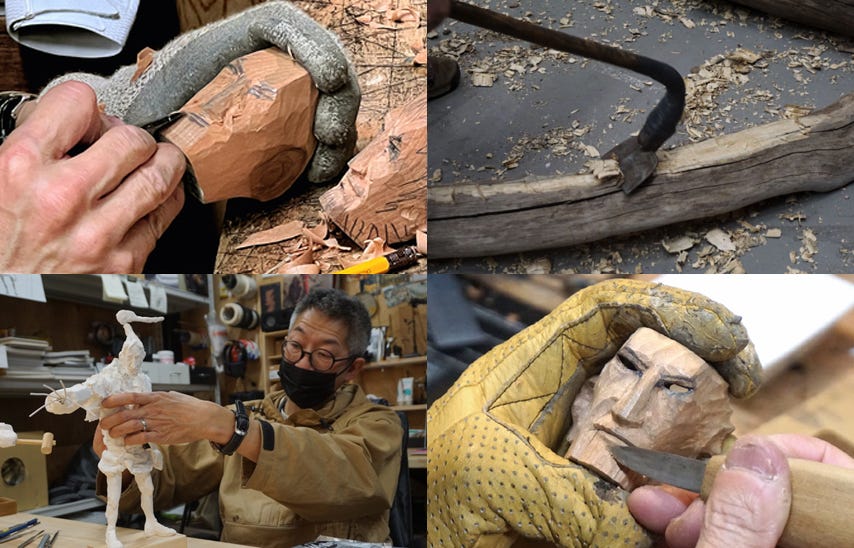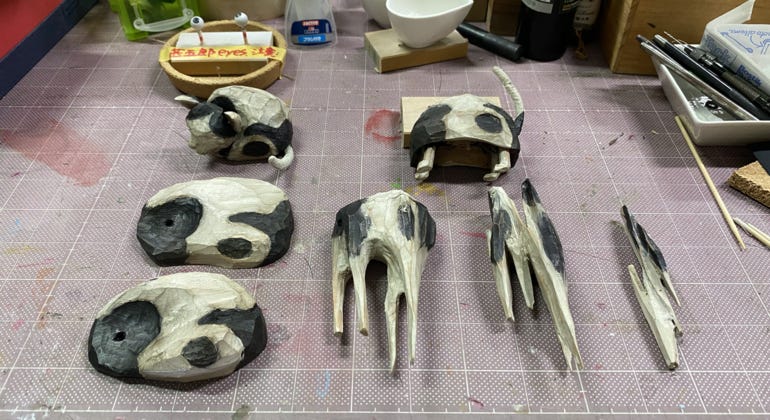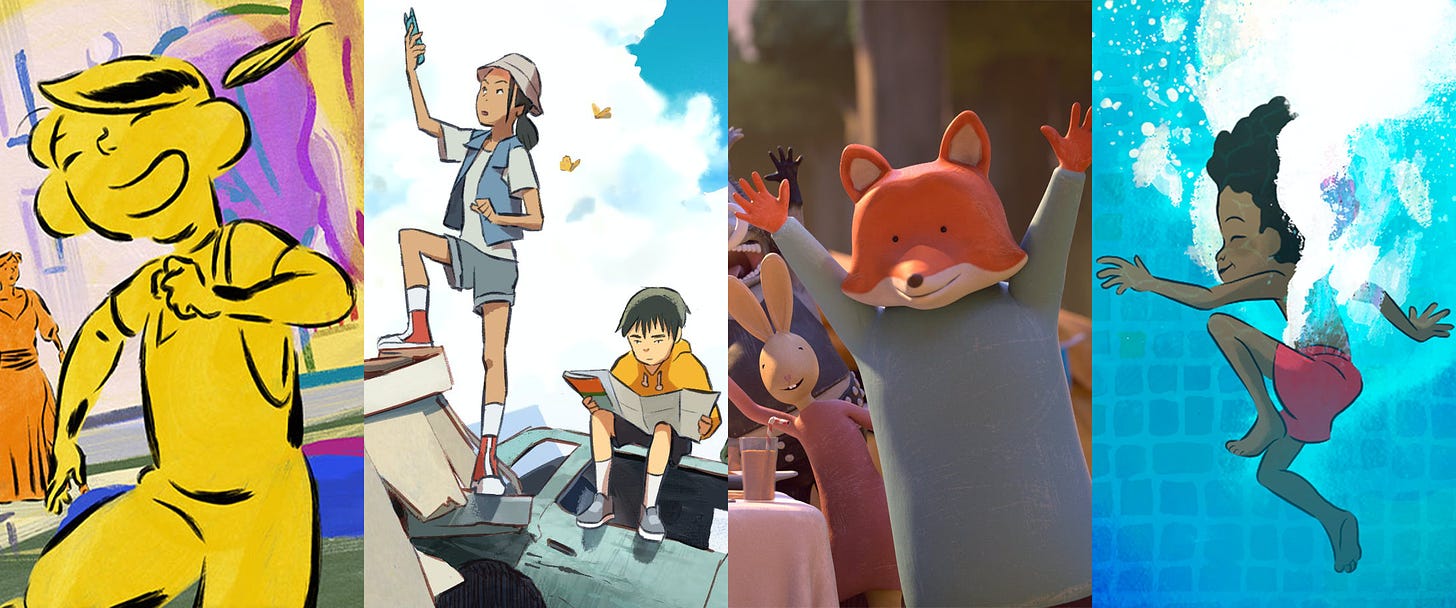Welcome back! We’re here with another issue of the Animation Obsessive newsletter — and today’s plan goes like this:
1️⃣ A chat with Masashi Kawamura, director of Hidari.
2️⃣ International animation newsbits.
If you’re new here, you can sign up for free to receive our weekly Sunday issues, right in your email inbox. Join 10,000+ readers from around the world:
With that, let’s go!
1: What is Hidari?
Last year, a certain stop-motion project from Japan appeared on our radar. It’s called Hidari — a hyper-stylish samurai film made out of wood. It was already looking great mid-production. When its trailer dropped last month, we began to get very excited.
Finally, this week, Hidari’s five-minute pilot was released to wide acclaim from social media and the press. And for good reason: it’s fantastic. You can watch it (embedded) a little further down.
Hidari is an action film set in Edo Japan, starring wooden puppets. It’s about Jingorō Hidari, a sculptor and polymath — who may or may not have actually existed between the 1500s and 1600s. The film reimagines him as a fighter in a classic samurai tale. Three Japanese firms collaborated to make it all happen: Whatever Co. and the stop-motion studios TECARAT (Gon, the Little Fox) and Dwarf (Rilakkuma).
The launch of the Hidari pilot ties into a crowdfunding campaign. Its team is looking to raise funds to promote this project and sign partner studios, to develop the short into a feature film. It blew past its Kickstarter goal, two million yen, in two days.1 The campaign is ongoing until April 25 — find it here.
Given Hidari’s success, and how great the pilot proved to be, we reached out to its director, writer and mastermind: Masashi Kawamura, the Chief Creative Officer of Whatever Co. He’s a veteran who’s grabbed headlines and awards with his multimedia work for years, all the way back to a viral music video he co-directed for the band Sour in 2009.
Kawamura was kind enough to answer a few questions about Hidari. Our interview, edited for clarity and formatting, follows:
Animation Obsessive: How did the idea for Hidari first come about?
Masashi Kawamura: I am always motivated by the desire to create something that no one has ever seen before, in all my creative activities. This project started when I received an invitation from Noriko Matsumoto, a producer at Dwarf Studios, whom I have collaborated with on several projects in the past, to create original content together.
I thought it would be interesting to come up with new stop-motion animation ideas with Dwarf Studios, and, while brainstorming various ideas, I suddenly remembered a character I had read about in the past named “Jingorō Hidari.”
Although many works attributed to Jingorō Hidari still exist, such as the “sleeping cat” at Nikkō Tōshō-gū, the character himself is shrouded in mystery and his existence is unknown, which I found very intriguing (similar to the mysterious street artist Banksy). In rakugo and kōdan, traditional Japanese storytelling art forms, Hidari is often portrayed as a woodcarver whose carved animals come to life, which reminded me of stop-motion animation, where life is breathed into inanimate objects.
That’s when I came up with the idea of creating a samurai film with Jingorō Hidari as the protagonist: using wooden puppets, just like his creations, and bringing them to life with the stop-motion animation technique. I also had this image of sawdust spewing out instead of blood when characters are slashed, since the characters are all made of wood.
These imaginations really excited me, and I really believed that they would result in a unique and never-before-seen animated film. When I proposed this idea to the team, they loved it and said, “Let’s do this!” and thus the long production began.
What was involved in making a five-minute pilot for this project?
One-and-a-half years of production time. Over 60 staff members. Two Jingorō puppets, one Inumaru puppet, five henchmen puppets, one Inumaru robot, one sleeping cat puppet (with five motion-blur models) and one armchair dog puppet. Five filming stages. Fourteen scenarios (which ended up being cut down to mostly action scenes, to focus on the visual qualities more than the narrative for this pilot film). Lots of love, sweat, tears and sawdust.
Hidari is a stop-motion film, but it has the pacing and feel of 2D animation. How does the team achieve that?
Yes, we took many cues from action scenes in 2D animation, especially classic “Japanimation.” We really wanted to bring dynamic action sequences into stop-motion animation, since we’ve never seen it done before.
We collected a team of talented animators led by Kimimasa Inazumi, who shared this same vision and passion. We discussed many scenes from animated and live-action films to align the type of animation we wanted to create, and, from there, went into creating a “test animation” (below) to see what we could potentially do.
From there, we noted where we wanted to make further adjustments to the motion, lens and camera angles, and drafted a production plan that allowed us to achieve them all.
What are some of the tricks used to give the film that 2D “Japanimation” feel you mentioned — things that aren’t done in most stop-motion films?
Dynamic camera movements (we used the Volo motion control crane), extremely warped images made by changing and mixing different lenses within a scene, overtly emphasized perspective for a more dramatic effect, dynamically shifting the frames per second during sequences to accentuate the fast and slow actions, etc.2
Has any shot or effect been especially challenging so far?
Basically, everything was challenging [smile]. The animators were saying that animating just one Jingorō puppet was like moving three puppets at once, since he’s bigger than a usual puppet for animation (40 cm), and his proportions do not allow him to stand up on his own, so he had to be lifted up by a rig all the time.
I personally felt the “smear frames” (or motion blur effects) of the chainsaw were a nightmare to film, because they had to be hung by invisible wires to keep their shape, and we had to detach and move them one frame at a time…
What are some of the key inspirations behind the project?
I grew up watching work by Ray Harryhausen, Phil Tippett and Kihachirō Kawamoto, so I was always fascinated by stop-motion animation. Plus, I loved watching action flicks with my dad like Army of Darkness, RoboCop, Aliens, Lady Snowblood, The Blade… you can definitely see the influence from these films, for sure.
In terms of the action scenes, we watched and studied a lot of Japanese animation plus films like 300, Kingsman, The Raid and John Wick.
Hidari is a co-production between several studios. How did they get involved, and how has the collaboration between the teams played out?
Noriko Matsumoto, a producer at Dwarf, was the one who initially reached out to me to think of an original film idea to produce together. I’d worked with her before on several projects like The Diary of Ochibi, the opening animation for Scarlet, etc.
We brought in Takeshi Yashiro of TECARAT as the puppet designer, once we’d decided on the concept of creating an animation using “wooden puppets,” since he has done a few works in the past using this style. Animation work was done by the animators at Dwarf plus external animators. Kimimasa Inazumi was the main animator for all the action scenes, and Shigeru Okada (Rilakkuma) led the other scenes.
The collaboration was amazingly smooth, because I guess everyone really rooted for this idea. Everyone gave 120%, which I think resulted in this high-quality pilot film.
Since Hidari is having success on Kickstarter, what’s next in the quest to make it a feature-length movie?
Ultimately, our goal is to turn this Hidari project into a full-length feature film. However, this will require significant funding and a much, much larger production team, so we decided to first create a pilot film visualizing this world of “wooden stop-motion samurai” using our own funds.
Now that we have the pilot film completed, we plan to use it as a tool to approach various production and distribution companies and seek their collaboration in turning this into a full-length film. I hope we can show the feature film to our supporters, as soon as we can.
We’d like to thank Masashi Kawamura for chatting with us. You’ll find Hidari’s Kickstarter campaign here. As of this writing, the project is over twice its funding goal, and climbing.
The money goes to the next stage of Hidari’s production plan. The team explains on the campaign page that it needs funding for:
… further sales and PR activities to find the production partner we need for the feature-length film. We are planning to pitch Hidari to major film studios and film distributors around the world, and screen it in events like Niigata Animation Film Festival and trade shows such as MIFA in Annecy.
Making a stop-motion feature is never straightforward, even for experienced teams like the ones involved in Hidari. If all goes well, they hope to have their partners signed by mid-2024 and to start pre-production in 2025. There’s a long road ahead.
We wish the creators well. With luck, the fast-growing hype around Hidari will make it easy to land partners for this ambitious, one-of-a-kind idea.
2: Animation news worldwide
Highlights from Cartoon Movie
Cartoon Movie is an annual event that decides the future of animation. It isn’t loud about what it does — when it happens in France each year, it draws little mainstream notice. That isn’t really the point. “Cartoon Movie is neither a fair nor a festival,” says the about page. It’s a place for people to network.
Most European animated features pass through Cartoon Movie. Studios pitch their ideas to people with money, win over co-production partners and get projects in front of distributors. This week, for three days in Bordeaux, it happened again. Cartoon Movie 2023 showcased “58 projects from 16 countries,” reported Animation Magazine.
Data from the event reveals that the presentation for Julián, the new film by Ireland’s Cartoon Saloon (Wolfwalkers), was among the best-attended by potential buyers. It comes from director Louise Bagnall, already an Oscar nominee for her short film Late Afternoon. The studio bills Julián as “the story of a boy who wants to be a mermaid.”
The film was the most-attended pitch among co-productions between multiple countries (five are involved, including Ireland). Julián took second place in attendance for all films, beaten only by Back to Tomioka — produced in France.
Tomioka is a big one, too. It’s directed by Michaël Crouzat, an animator known for his work on projects like Ernest & Celestine and The Big Bad Fox and Other Tales. The film centers on Fukushima: two orphans embark on a journey through the disaster area to “lay their grandmother’s ashes at the family altar located in Tomioka, in the heart of the forbidden zone.” A public trailer emerged from the event this week.
Another project drawing plenty of interest at Cartoon Movie was Fox and Hare Save the Forest from the Netherlands — which uses 3D animation to create a very charming, convincing stop-motion look. Cartoon Brew has an article (and video) about the film.
Much more happened at Cartoon Movie, including a first trailer for Chicken for Linda! — the unlikely feature about a mother trying to cook “chicken with peppers” for her daughter. The Eurimages Co-Production Development Award (a €20,000 prize) went to I’m Still Alive, an Italian feature based on a graphic novel illustrated by Asaf Hanuka, one of the artists behind the film Waltz with Bashir. This is just the start.
For more on Cartoon Movie 2023, we recommend the trailer roundups from Catsuka and Radix, and the event breakdown from Animation Magazine. You can browse the projects yourself via the Cartoon Movie website.
Newsbits
We lost illustrator and writer Ian Falconer (63), the creator of the Olivia children’s book series that inspired the animated show.
In America, the Oscars for animation went to The Boy, the Mole, the Fox and the Horse in the shorts category and Guillermo del Toro’s Pinocchio among feature films. “Animation is cinema; animation is not a genre,” said del Toro in his speech. A welcome corrective after last year.
A Canadian filmmaker has made a ridiculously high-effort parody of Glass Harmonica, the Soviet surrealist classic. It finds life in an old Simpsons meme — remixing the “steamed hams” bit into possibly its weirdest form yet. Bill Oakley, who wrote the original, loves it. (Thanks to EasternOoC for sharing this.)
In China, Deep Sea continues its success in theaters. The film has now surpassed 900 million yuan (around $130 million). That’s close to the 956 million earned by Monkey King: Hero Is Back, by the same director, in 2015.
A big story from America. Production managers, supervisors and coordinators have unionized at Walt Disney Animation Studios — the branch of the company behind the mainline animated features. Disney is reportedly dragging its feet so far, refusing to recognize supervisors and managers as part of the union.
The American series Kiff is out. It’s created by Nic Smal and Lucy Heavens of South Africa — AWN has a good, detailed article and interview about it.
In Mexico, the animated documentary Home Is Somewhere Else will hit theaters in April, following its tour of the festival circuit. It tells three true stories that revolve around the border, undocumented immigration and Dreamers.
During its first weekend in Ukraine, Mavka: The Forest Song sold roughly 189,000 tickets and earned 24.9 UAH (around $680,000). That’s a reported box-office record for a domestic film. Mavka has already opened in the Middle East and North Africa, and has a broad, global rollout planned for the rest of 2023.
Lastly, we told the story behind the silencing of Glass Harmonica, the Soviet Union’s most notoriously banned animation. It’s a winding odyssey through the machinery of the USSR.
Until next time!
This dynamic shifting of frames per second is sometimes called “frame-rate modulation,” a key technique used in Japanese 2D animation — especially today.








So much animation's happening in Europe that barely gets any press in America - so thanks for the summary of Cartoon Movie!!!
Wow. I'm blown away by Hidari. The expressiveness achieved with these wooden puppets, the camera movement, editing—all superb. It feels *new,* and that's exciting.